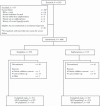The incidence of hypoglycaemia in Muslim patients with type 2 diabetes treated with sitagliptin or a sulphonylurea during Ramadan: a randomised trial
- PMID: 21951832
- PMCID: PMC3253336
- DOI: 10.1111/j.1742-1241.2011.02797.x
The incidence of hypoglycaemia in Muslim patients with type 2 diabetes treated with sitagliptin or a sulphonylurea during Ramadan: a randomised trial
Abstract
Aims: To compare the incidence of symptomatic hypoglycaemia in fasting Muslim patients with type 2 diabetes treated with sitagliptin or a sulphonylurea during Ramadan.
Methods: Patients with type 2 diabetes (age ≥ 18 years) who were treated with a stable dose of a sulphonylurea with or without metformin for at least 3 months prior to screening, who had an HbA(1c) < 10% and who expressed their intention to daytime fast during Ramadan were eligible for this open-label study. Patients were randomised in a 1 : 1 ratio to either switch to sitagliptin 100 mg qd or to remain on their prestudy sulphonylurea. Patients completed daily diary cards to document information on hypoglycaemic symptoms and complications. The primary end-point was the overall incidence of symptomatic hypoglycaemia recorded during Ramadan.
Results: Of the 1066 patients randomised, 1021 (n = 507 for sitagliptin and n = 514 for sulphonylurea) returned at least one completed diary card and were included in the analysis. The proportion of patients who recorded one or more symptomatic hypoglycaemic events during Ramadan was lower in the sitagliptin group (6.7%) compared with the sulphonylurea group (13.2%). The risk of symptomatic hypoglycaemia was significantly decreased with sitagliptin relative to sulphonylurea treatment (Mantel-Haenszel relative risk ratio [95% CI] = 0.51 [0.34, 0.75]; p < 0.001). There were no reported events that required medical assistance (i.e. visits to physician or emergency room or hospitalisations) or were considered severe (i.e. events that caused loss of consciousness, seizure, coma or physical injury) during Ramadan.
Conclusions: In Muslim patients with type 2 diabetes who observed the fast during Ramadan, switching to a sitagliptin-based regimen decreased the risk of hypoglycaemia compared with remaining on a sulphonylurea-based regimen. The incidence of hypoglycaemia was lower with gliclazide relative to the other sulphonylurea agents and similar to that observed with sitagliptin.
© 2011 Blackwell Publishing Ltd.
Figures

References
-
- Salti I, Benard E, Detournay B, et al. A population-based study of diabetes and its characteristics during the fasting month of Ramadan in 13 countries: results of the epidemiology of diabetes and Ramadan 1422/2001 (EPIDIAR) study. Diabetes Care. 2004;27:2306–11. - PubMed
-
- Inzucchi SE. Oral antihyperglycemic therapy for type 2 diabetes: scientific review. JAMA. 2002;287:360–72. - PubMed
Publication types
MeSH terms
Substances
LinkOut - more resources
Full Text Sources
Medical
Miscellaneous

